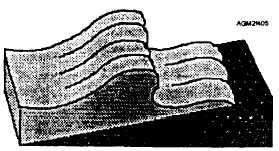this information in the Remarks section, element
HOTEL. An evaluation of the offshore breaker height
and type should be included with the remarks. For
example, HOTEL: HIGHER BREAKERS 50 YD
OFFSHORE, ALFA 9 PT 0, BRAVO 12 PT 5, DELTA
80 PLUNG 20 SPILL. Elements CHARLIE, ECHO,
FOXTROT, and GOLF need not be included in the
remarks section.
Breaker Period (CHARLIE)
The total time (in seconds) for 100 successive
waves to be observed, divided by 100, is the average
breaker period. This value is entered to the nearest half-
second as element CHARLIE of the report. The
average breaker period is normally the same or very
close to the deep-water wave period. Generally,
breakers with shorter periods are much more difficult
for landing craft to negotiate.
Breaker Type (DELTA)
Breakers are classified as spilling, plunging, or
surging breakers, depending on their appearance (fig.
4-5). The steepness of the wave front, a function of the
slope of the bottom, is the most critical factor as to what
type of breaker will be formed. Bottom irregularities
and local winds also influence breaker type. Keep in
mind that breaker characteristics can vary considerably
with respect to time and location.
Spilling breakers occur with gentle and flat beach
slopes. As a wave moves toward the beach, steepness
increases gradually and the peak of the crest gently slips
down the face of the wave. The water at the crest of a
wave may create foam as it spills over.
Spilling
breakers also occur more frequently when deep-water
sea waves approach the beach. The shorter wavelength
of a sea wave means that the wave is steeper in the deep
water and that the water spills from the crest as the
waves begin to feel bottom. Because the water
constantly spills from the crest in shorter wavelength
(shorter period) waves, the height of spilling waves
rarely increases as dramatically when the wave feels
bottom, as do the longer period waves. Because they
occur on mild sloping beaches, spilling breakers
typically produce surf zones that extend far offshore.
Plunging breakers occur with a moderate to steep
beach slope. In this type of breaker, a large quantity of
water at the crest of a wave curls out ahead of the wave
crest, temporarily forming a tube of water on the wave
face, before the water plunges down the face of the
wave in a violent tumbling action. Plunging breakers
BEACH USUALLY FLAT
A. SPILLING BREAKER
BEACH USUALLY MODERATE TO STEEP
B. PLUNGING BREAKER
BEACH USUALLY VERY STEEP
C. SURGING BREAKER
Figure 4-5.—General character of (A) spilling, (B) plunging,
and (C) surging breakers.
are characterized by the loud explosive sound made
when the air trapped in the curl is released. Plunging
breakers are more commonly associated with swell
waves, which approach the beach with much longer
wavelengths. The shortening of the wavelength as the
wave feels bottom causes a great mass of water to build
up in the crest in a short time. Longer period swell
waves may double in height when feeling bottom
4-6






